The Police of the Republic of Armenia (Armenian: Հայաստանի Հանրապետության ոստիկանություն, romanized: Hayastani Hanrapetut’yan vostikanut’yun) is the national police of Armenia.[1][2]
| Police of Armenia Հայաստանի ոստիկանություն | |
|---|---|
 Emblem of the Police of Armenia | |
| Common name | Police of Armenia |
| Abbreviation | Armenian Police |
| Agency overview | |
| Formed | 2002 |
| Operational structure | |
| Headquarters | 130 Nalbandyan St Yerevan |
| Agency executive |
|
| Parent agency | Ministry of Internal Affairs of Armenia Government of Armenia |
| Website | |
| police | |
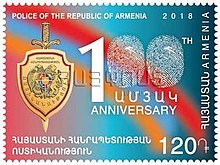
History
Soviet era
The first police service of Armenia was formed in 1918, under the Ministry of Internal Affairs of the First Republic of Armenia. On April 21, 1920, a Militia was formed in Yerevan based on the Soviet model. It was later renamed to the People's Commissariat of Internal Affairs of the Armenian SSR or the NKVD of the Armenian SSR, which was the Armenian subordinate to the NKVD headquarters in Moscow. In 1929, the NKVD of the Armenian SSR was dissolved and was reestablished in July 1934 as a reorganized political department. During World War II, the present-day building of the Armenian Police was built. The Armenian Regiment of Interior Forces of the USSR Ministry of Internal Affairs was established in 1963, and the Headquarters of the Ministry of Internal Affairs of the Armenian SSR was founded in 1965.
Modern Armenia
On June 21, 1992, by order of President Levon Ter-Petrosyan, the Ministry of Internal Affairs of Armenia was formed from the former Soviet Internal Troops.[3] The ministry was active until December 2002, when the ministry, along with the Ministry of National Security, was reorganised into a non-ministerial institution, with the Ministry of Internal Affairs becoming the Police of Armenia.[4] The Armenian Ministry of Justice recommended the re-establishment of the ministry headed by a cabinet member in a three-year strategy of police reforms proposed to the government in 2019.[5] As part of a major structural reform of the national police service, Prime Minister Nikol Pashinian announced plans to recreate the Interior Ministry.[6][7] A patrol service became active in June 2021.[8]
On 16 September 2021, the Armenian Government signed a strategic cooperation agreement with Europol.[9][10]
On 25 January 2024, a more complex cooperation agreement with Europol was ratified by the Armenian government. The agreement will facilitate the deployment of a liaison officer from Armenia's Ministry of Internal Affairs to Europol, enhancing operational collaboration and information exchange between Armenia and Europol.[11] On 2 February 2024, Deputy Minister of Internal Affairs, Police Chief Major General Aram Hovhannisyan held meetings with Europol Executive Director Catherine De Bolle and CEPOL Executive Director Montserrat Marín López. The sides discussed the implementation of the provisions of the agreement signed between the Armenian police and Europol, as well as joining the SIENA system, among other issues of mutual interest.[12]
Leadership
The activities of the police are directed by the chief of the police, who is appointed by the president of Armenia at the nomination of the prime minister of Armenia.[1] The chief has one first deputy and several deputies,[13] appointed by the president upon nomination by the chief.[1]
The commander of the police troops is appointed by the president and serves as ex officio deputy chief of the police.[1] Each of the deputy chiefs is assigned a sphere of responsibility by the chief of police, who is also assisted by a group of Advisers.[1]
List of leaders (since 2003)
- Hayk Haroutyunyan (January 2003 – May 29, 2008)
- Alik Sargsyan (May 29, 2008 – November 1, 2011)
- Vladimir Gasparyan (November 1, 2011 – May 10, 2018)
- Valeri Osipyan (May 10, 2018 – September 19, 2019)
- Arman Sargsyan (September 19, 2019 – June 8, 2020)
- Vahe Ghazaryan (June 8, 2020 – Present)
Central Body and Regional Divisions
The Police are organised into the Central Body, and 11 geographic divisions.[1] There is one police department for the city of Yerevan, and one for each of the 10 Provinces. The Departments of the Central Body are:[1]
- Headquarters
- Combating Organized Crime Main Department
- Criminal Investigations Main Department
- Investigative Main Department
- Public Order Department
- Personnel Department
- Information Centre
- Public Relations and Press Department
- Finances and Economic Affairs Department
- Administration
- Department of Road Inspection
- Passports and Visas Department
- State Protection Department
- Criminal Forensics and Legal Affairs Department
- National Central Bureau (NCB) of Interpol
National Central Bureau
The NCB is divided into three divisions:[13][14]
- Division for international search and general crime – responsible for conducting criminal investigations of an operational nature, preparing international notice requests and sending them to the General Secretariat for publication, providing liaison and co-ordination activities, maintaining criminal records, implementing criminal investigations concerning the search for wanted persons. The division comprises 6 police officers including a head of division.
- Division for the analysis and processing of criminal intelligence – division deals with the following areas: legal matters, analysis and processing of criminal intelligence on drug trafficking, fraud, organized crime, terrorism, corruption, counterfeiting, crimes against human beings, international relations support, general reference sources, methodological data, etc. It comprises 6 police officers including a head of division.
- Division for telecommunications and technical support – division deals with matters relating to information technology systems, providing telecommunications services and technical support for the NCB. It consists of 7 police officers including a head of division.

Public Relations and Press Department
The Committee of Public Relations (part of the Public Relations and Press Department) was founded on 21 March 1994.[15]
The department also maintains a 42-member Police Band (Հայաստանի ոստիկանության նվագախումբը, Vostikanutyan Nvagaxumb) based in Yerevan which is currently led by Baghdasar Grigoryan. The band was created on 1 August 1972. It performs similar functions to the Band of the Armenian Army General Staff, taking part in the most important events of the police and the state.[16] In 2019, it performed at the graduation party of Dubai Police Academy.[17]
Police Troops
The Armenian Police Troops (Armenian: Հայաստանի Հանրապետության ոստիկանության զորքեր) are composed mainly of personnel from the former Police Special Forces (SDFs) and the Rapid Reaction Forces (SDFs), who have actively participated in all combat operations carried out by the former Armenian Internal Troops and the Soviet Internal Troops. On 21 June 1992, the Internal Troops of the Ministry of Internal Affairs were formed by decree of Levon Ter-Petrosyan.[4] The day of formation of the police troops is celebrated every year, on 21 June. In February 1999 the Deputy Minister of the Interior and Commander of the Internal Troops, Major General Artsrun Makarian, was found shot dead. On 14 December 2004, the Internal Troops were renamed to the Police Troops.[18] In 2009, there was a transition from conscription to contract service. In 2013 the International Institute for Strategic Studies attributed the force with four paramilitary battalions, 55 AIFV including 44 BMP-1, and 24 wheeled armoured personnel carriers.[19]
The military units of the Internal Troops of the Armenian Ministry of Internal Affairs had a wide range of activities: including the protection of special facilities, maintenance of public order, public security service, preliminary training of conscripts, and training of non-commissioned officers. The Internal Troops had a helicopter (aviation) unit, which, being provided with appropriate helicopters, performed various transportation services during combat operations.[20]
Wars
It took part in the Four-Day War and the Second Nagorno-Karabakh War. During the latter war, sixty-five policemen were killed and six were considered missing. About 3,000 officers from the police troops went to the battlefront in shifts and took part in battles for Karvachar, Haterk, Jrakan, Berdzor and Shushi-Lisagor road.[21] In 2018, it was deployed to the Armenia–Azerbaijan border.[22][23] It also took part in the First Nagorno-Karabakh War.[24]
Special Operations Forces
It has carried out raids in the places of alleged "thieves' gatherings".[25] It took part in the "Cobalt-2016" joint exercise of special forces units of the CSTO at the Marshal Baghramyan Training Ground of the Ministry of Defense.[26]
Personnel
Oath
Persons serving in the Police, in front of the state flag of Armenia, in accordance with the procedure established by the Government of Armenia, take an oath with the following content:[27]
"I (name, patronymic, surname), taking service in the Police of the Republic of Armenia, swear:
To be faithful to the constitutional order of the Republic of Armenia, to be unconditionally governed by laws, to defend my homeland, to keep state and official secrets.
To exercise my powers fairly and impartially, to perform my official duties honestly and conscientiously."
Uniforms
Decrees passed in October 2002 and April 2003 set the rules for police officers' uniforms.[1]
Weapons
Police personnel are armed primarily with Soviet-made firearms and ammunition, including Makarov PM and Tokarev TT-33 handguns, and AKS, AKM, and AK-74 automatic rifles.[1]
Police Workers Day
Celebrated on 16 April, Police Workers Day (Armenian: Ոստիկանության օր) in Armenia commemorates personnel of the Police Central Body and the Police Troops. It was first celebrated in 2002 and was introduced year earlier by the National Assembly of Armenia. Traditionally, the President of Armenia and/or the Prime Minister of Armenia receives the salute at a ceremony in the Yerevan police headquarters.[28]
Ranks
Police ranks are classified into the following groups:[29]
- Higher ranks
- Colonel General of Police
- Lieutenant General of Police
- Major General of Police
- Chief ranks
- Police Colonel
- Senior ranks
- Police Lieutenant Colonel
- Subaltern ranks
- Police Major
- Police Captain
- Senior Police Lieutenant
- Police Lieutenant
- Junior ranks
- Senior Police NCO
- Police NCO
- Police Starshina
- Senior Police Sergeant
- Police Sergeant
- Junior Police Sergeant
Education
The Police Academy of Armenia, is the successor to the Secondary School of the Internal Troops of the Ministry of Internal Affairs, which was founded in 1984. During the Soviet era, the Yerevan Higher School of the Ministry of Internal Affairs operated in the country.[30]
Equipment
Small arms
| Name | Origin | Type | Photo |
|---|---|---|---|
| Pistols and submachine guns | |||
| MP-443 Grach |  Russia Russia | 9×19mm |  |
| Glock |  Austria Austria | 9×19mm |  |
| M1911 |  United States United States | .45 ACP |  |
| Makarov |  Soviet Union Soviet Union | 9×18mm |  |
| Tokarev TT-33 |  Soviet Union Soviet Union | 9×19mm |  |
| AK-74U |  Soviet Union Soviet Union | 5.45×39 mm |  |
| Assault Rifles | |||
| AK-74M |  Russia Russia | 5.45×39 mm |  |
| AK-74 |  Soviet Union Soviet Union | 5.45×39 mm |  |
| AKS-74 |  Soviet Union Soviet Union |  | |
| AKM |  Soviet Union Soviet Union | 7.62×39 mm |  |
| Sniper rifles | |||
| Dragunov SVD |  Soviet Union Soviet Union | 7.62×54 mm |  |
Vehicles
| Name | Origin | Type | Photo | Notes |
|---|---|---|---|---|
| Vehicles and Aircraft | ||||
| Škoda Octavia |  Czech Republic Czech Republic | Patrol Car |  | The latest models issued to the traffic police also known as Patrol. Slowly replacing Toyota Corolla and Camry models.[31] |
| Toyota Corolla |  Japan Japan | Patrol Car |  | Used as primaries. |
| Toyota Camry |  Japan Japan | Patrol Car |  | Used as secondaries. |
| Kia Forte / Cadenza |  South Korea South Korea | Patrol Car |  | Gifted by South Korea to the Armenian Patrol Sentry Service Regiment.[32] |
| Chevrolet Sonic / Aveo |  United States United States | Patrol Car |  | General Department of State Protection of the Police.[33] |
| Hyundai Elantra |  South Korea South Korea | Patrol Car |  | Used also by the Military Police. |
| Lada VAZ |  Soviet Union Soviet Union | Patrol Car |  | Currently being replaced. A few are still in service. |
| Lada Priora |  Russia Russia | Patrol Car | 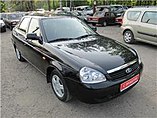 | Used in rare situations. |
| IKCO |  Iran Iran | Patrol Car |  | Used by some units, being replaced widely. |
| Dodge Charger |  Canada Canada | Patrol Car |  | Tested in 2019. 300 units being delivered. Not seen in the public. |
| Ford Crown Victoria |  Canada Canada | Patrol Car | 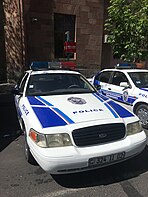 | As of 2020[update] there are 10 vehicles in service in Yerevan only;[34][35][36][37] rarely used. |
| Toyota Prado |  Japan Japan | Police SUV |  | Used as a VIP transport. Old variants used by patrol and special units. |
| Hyundai Tucson |  South Korea South Korea | Police SUV |  | |
| UAZ-469 |  Soviet Union Soviet Union | Police SUV | 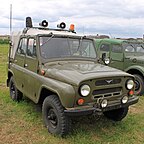 | Used mostly in rural areas. |
| Chevrolet Niva |  Russia Russia United States United States | Police SUV |  | Distributed to different divisions.[38] |
| UAZ Patriot |  Russia Russia | Police SUV |  | Used in support roles. |
| Toyota C-HR |  Japan Japan | Police SUV |  | New in service. |
| Chevrolet Tahoe |  United States United States | Unmarked Vehicle |  | Unmarked. |
| Mercedes-Benz G-Class |  Germany Germany | Unmarked Vehicle |  | Used as VIP transport. |
| Chevrolet Express |  United States United States | Transportation Vehicle |  | Unmarked transportation vehicle. Also used as prisoner transport.[39] |
| Hyundai Starex |  South Korea South Korea | Transportation Vehicle |  | Used by the Armenian Patrol Sentry Service Regiment. |
| GAZelle |  Russia Russia | Transportation Vehicle | 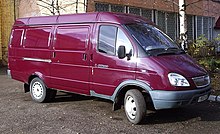 | Used by specialized units. Some unmarked.[39] |
| Toyota Hiace |  Japan Japan | Transportation Vehicle |  | Support roles.[39] |
| UAZ-452 |  Soviet Union Soviet Union | Transportation Vehicle |  | Mostly used in support roles. |
| Volkswagen Transporter |  Germany Germany | Transportation Vehicle | 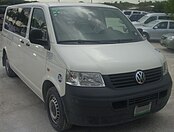 | Limited use.[39] |
| PAZ-3205 |  Soviet Union Soviet Union | Transportation Vehicle |  | Used for riot roles and transport. |
| Ural-4320 |  Soviet Union Soviet Union | Transport / Cargo Truck |  | Few converted to riot trucks. |
| KamAZ-43501 |  Russia Russia | Transport / Cargo Truck |  | Very limited usage. |
| CNHTC Riot Control |  China China | Riot Control Vehicle |  | Fitted with armored and riot equipment. Used for riot control.[39] |
| GMC Grumman |  United States United States | Riot Control Vehicle | 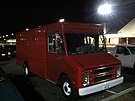 | Fitted with armored and riot equipment. Used for riot control and prisoner transport.[39] |
| GAZ-2975 "Tigr" |  Russia Russia | Armored Vehicle |  | Used by special forces, riot police, and rapid response units. |
| BTR-80 |  Soviet Union Soviet Union | Armored Personnel Carrier |  | Used for riot control and counter-terrorism. Most APCs have their guns replaced with water cannons. |
| BRDM-2 |  Soviet Union Soviet Union | Armored Personnel Carrier |  | Used for riot control. Guns replaced with water cannons. |
| Mi-8 |  Soviet Union Soviet Union | Transport Helicopter |  | Few used by the Armenian Police for transport.[39] |
| Eurocopter EC130 |  France France | Transport Helicopter |  | Few used for transporting and other operations.[40] |
| Eurocopter EC635 / EC 135 |  France France | Transport Helicopter |  | Few used for transporting and other operations.[41] |
See also
References
Links

- Official Website
- POLICE RA Vostikanutyun on YouTube
- Performances of the Police Band in 2017 and 2018
- The Police Honour Guard